Features: Flower Shows |  |
The RHS Flower Show at Tatton Park 2004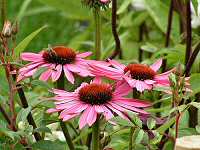 Coneheads (Echinacea purpurea) from the Simply William Morris garden. (View bigger image.)
The 2003 Tatton Park Flower Show, whilst it may have been a great horticultural spectacle, did not offer a great deal of specific interest to those who want to encourage wildlife into their gardens. The Royal Horticultural Society (RHS) graciously provided SpaceForNature with a press pass so that we could see if this, the sixth annual show, would be different. Coneheads (Echinacea purpurea) from the Simply William Morris garden. (View bigger image.)
The 2003 Tatton Park Flower Show, whilst it may have been a great horticultural spectacle, did not offer a great deal of specific interest to those who want to encourage wildlife into their gardens. The Royal Horticultural Society (RHS) graciously provided SpaceForNature with a press pass so that we could see if this, the sixth annual show, would be different.
I was fortunate enough to be able to visit the show on 'press day' which is the day before the show was officially opened. This meant that some of the exhibits and stands were not ready but thankfully all of the gardens were because it was also judging day for them. So although I was mostly limited to viewing the garden exhibits, I was able to get a very good look at all of them without the pressure of the crowds.
Simply William Morris
This was practically the first garden I saw at the show and it whet my appetite for what was to come. Designed by Butler Landscapes Ltd, this was a themed garden; an homage to the Victorian designer William Morris. Morris was most famous for his textile and wallpaper 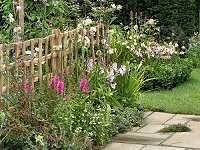 Cottage garden planting. (View bigger image.)
designs, but also had very strong opinions about garden design and planting, favouring cottage garden plants and the inclusion of native species. I am not normally a fan of overtly themed gardens, but this was not overtly themed. In fact had I not had the information at hand I would not have realised that it was themed at all. Cottage garden planting. (View bigger image.)
designs, but also had very strong opinions about garden design and planting, favouring cottage garden plants and the inclusion of native species. I am not normally a fan of overtly themed gardens, but this was not overtly themed. In fact had I not had the information at hand I would not have realised that it was themed at all.
 This garden did not need its 'theme' to be successful and that is tribute enough to the ideas of William Morris This garden did not need its 'theme' to be successful and that is tribute enough to the ideas of William Morris This garden did not need its 'theme' to be successful and that is tribute enough to the ideas of William Morris. I was immediately attracted to the garden on its own merits: it was completely surrounded by a dry-stone wall and beyond the wall This garden did not need its 'theme' to be successful and that is tribute enough to the ideas of William Morris. I was immediately attracted to the garden on its own merits: it was completely surrounded by a dry-stone wall and beyond the wall
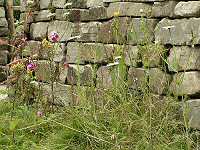 Naturalistic planting around the edge of the garden. (View bigger image.)
(i.e. outside the garden) grew wild flowers such as red campion (Silene dioica) and native grasses. Strictly speaking, being beyond the garden boundaries, I wonder if they can really be considered as part of the garden at all; but nevertheless, they were very effective. Naturalistic planting around the edge of the garden. (View bigger image.)
(i.e. outside the garden) grew wild flowers such as red campion (Silene dioica) and native grasses. Strictly speaking, being beyond the garden boundaries, I wonder if they can really be considered as part of the garden at all; but nevertheless, they were very effective.
The garden proper was dominated by geometrically strong design, but because of the emphasis on cottage garden type planting, it did not give the impression of being overly formal. Native species such as teasle (Dipsacus fullonum) were liberally intermixed with the other plants.  This was a 'wildlife garden' in the traditional vein with dry-stone walls, native plants and other well established features This was a 'wildlife garden' in the traditional vein with dry-stone walls, native plants and other well established features This was a 'wildlife garden' in the traditional vein with dry-stone walls, native plants and other well established features making it as attractive to garden wildlife as it was to people. The garden was awarded a gold medal by the RHS. This was a 'wildlife garden' in the traditional vein with dry-stone walls, native plants and other well established features making it as attractive to garden wildlife as it was to people. The garden was awarded a gold medal by the RHS.
The Stonemarket Path to Sanctuary Garden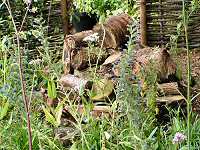 Log pile amongst naturalistic planting. (View bigger image.)
This was a very peaceful garden where the planting was designed, in part, to attract wildlife. Organically grown vegetables, a hedge incorporating native shrubs and plants like honeysuckle all helped to create a welcoming environment for wildlife and a relaxing space for people. Log pile amongst naturalistic planting. (View bigger image.)
This was a very peaceful garden where the planting was designed, in part, to attract wildlife. Organically grown vegetables, a hedge incorporating native shrubs and plants like honeysuckle all helped to create a welcoming environment for wildlife and a relaxing space for people.
The garden became progressively less formal the further back into it you travelled.  At the far end was the most naturalistic part incorporating such features as the (now almost ubiquitous) log pile At the far end was the most naturalistic part incorporating such features as the (now almost ubiquitous) log pile At the far end was the most naturalistic part incorporating such features as the (now almost ubiquitous) log pile shown in the picture. A beautiful and relaxing garden that included something for everyone. The garden was awarded a silver medal by the RHS. At the far end was the most naturalistic part incorporating such features as the (now almost ubiquitous) log pile shown in the picture. A beautiful and relaxing garden that included something for everyone. The garden was awarded a silver medal by the RHS.
Tomorrow's Garden for Wildlife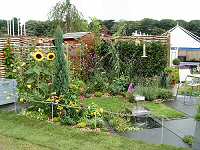 Tomorrow's Garden for Wildlife. (View bigger image.)
I don't know how many times I've written on this website and elsewhere that wildlife gardening should not be considered as a design idiom, but rather as a set of techniques which can be applied to gardens of all kinds. Well here was a garden with the stated aim of showing just that, Tomorrow's Garden for Wildlife. (View bigger image.)
I don't know how many times I've written on this website and elsewhere that wildlife gardening should not be considered as a design idiom, but rather as a set of techniques which can be applied to gardens of all kinds. Well here was a garden with the stated aim of showing just that,
 Contemporary water feature. (View bigger image.)
applying the full gamut of wildlife gardening techniques in a relatively formal garden. Contemporary water feature. (View bigger image.)
applying the full gamut of wildlife gardening techniques in a relatively formal garden.  The surprise to me was not that this garden succeeded, but that it carried it off so well in such a small space The surprise to me was not that this garden succeeded, but that it carried it off so well in such a small space The surprise to me was not that this garden succeeded, but that it carried it off so well in such a small space. This was one of the 'back to back' gardens at the show, but despite the limited area, English Nature and Chester Zoo packed in enough features and ideas to supply a garden of 10 times its size. The surprise to me was not that this garden succeeded, but that it carried it off so well in such a small space. This was one of the 'back to back' gardens at the show, but despite the limited area, English Nature and Chester Zoo packed in enough features and ideas to supply a garden of 10 times its size.
 One particularly successful element was the contemporary water feature; a stunning modern design that was nevertheless useful from the point of view of wildlife One particularly successful element was the contemporary water feature; a stunning modern design that was nevertheless useful from the point of view of wildlife One particularly successful element was the contemporary water feature; a stunning modern design that was nevertheless useful from the point of view of wildlife. It also incorporated child-safety grid which made it ideal for the garden of a family with young children. The garden was awarded a bronze medal by the RHS. One particularly successful element was the contemporary water feature; a stunning modern design that was nevertheless useful from the point of view of wildlife. It also incorporated child-safety grid which made it ideal for the garden of a family with young children. The garden was awarded a bronze medal by the RHS.
The Garden of the Future
This garden, designed and made by Reaseheath College in association with the Environment Agency, was classified as a 'show feature' and consequently was given a generous amount of space. The designers packed in all the wildlife gardening features used by other gardens (e.g. Tomorrow's Garden for Wildlife), but with the luxury of space they were able to set them more harmoniously within the garden.  Perhaps largely because of the luxury of space, this garden struck me as being the most successful wildlife garden I've yet seen at one of these shows Perhaps largely because of the luxury of space, this garden struck me as being the most successful wildlife garden I've yet seen at one of these shows Perhaps largely because of the luxury of space, this garden struck me as being the most successful wildlife garden I've yet seen at one of these shows. It delighted not only me but also, judging from the number and variety of insects I saw, the wildlife. The garden was awarded a gold medal by the RHS. Perhaps largely because of the luxury of space, this garden struck me as being the most successful wildlife garden I've yet seen at one of these shows. It delighted not only me but also, judging from the number and variety of insects I saw, the wildlife. The garden was awarded a gold medal by the RHS.
Naturalistic gardens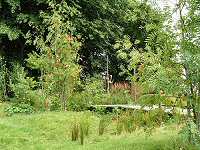 The Woodland Room Garden with rowan trees (Sorbus aucuparia). (View bigger image.)
A number of gardens at the show were designed more or less in the naturalistic idiom (though sometimes with a contemporary twist). The inclusion of native species, and other features warrants them a mention here. The Woodland Room designed by Alan Gardener attempted to illustrate the evolution of an area of manicured lawn through several stages into mature woodland. Although The Woodland Room Garden with rowan trees (Sorbus aucuparia). (View bigger image.)
A number of gardens at the show were designed more or less in the naturalistic idiom (though sometimes with a contemporary twist). The inclusion of native species, and other features warrants them a mention here. The Woodland Room designed by Alan Gardener attempted to illustrate the evolution of an area of manicured lawn through several stages into mature woodland. Although 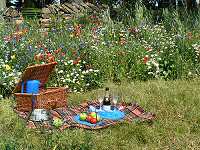 The PDSA 'Walkies' Garden with cornfield annuals. (View bigger image.)
I feel that a big idea like that needs more space to be carried off effectively, the garden was nonetheless an attractive and relaxing space. The garden was awarded a silver medal by the RHS. The PDSA 'Walkies' Garden with cornfield annuals. (View bigger image.)
I feel that a big idea like that needs more space to be carried off effectively, the garden was nonetheless an attractive and relaxing space. The garden was awarded a silver medal by the RHS.
The PDSA 'Walkies' Garden (People's Dispensary for Sick Animals) was a genuinely naturalistic design with the stated aim of encouraging dog owners to experience the delights of the English countryside.  The garden was dominated by a stunning area of cornfield annuals billed (as in other gardens) as a 'wildflower meadow' The garden was dominated by a stunning area of cornfield annuals billed (as in other gardens) as a 'wildflower meadow' The garden was dominated by a stunning area of cornfield annuals billed (as in other gardens) as a 'wildflower meadow'. At the risk of sounding pedantic, I am irked by the labelling of areas of cornfield annuals as 'meadow'. To me, the term 'meadow', implies a permanent area dominated by grasses and perennial wildflowers and I think using the term more loosely contributes to a common misconception about wildflower meadows amongst the public at large. The garden was awarded a silver medal by the RHS. The garden was dominated by a stunning area of cornfield annuals billed (as in other gardens) as a 'wildflower meadow'. At the risk of sounding pedantic, I am irked by the labelling of areas of cornfield annuals as 'meadow'. To me, the term 'meadow', implies a permanent area dominated by grasses and perennial wildflowers and I think using the term more loosely contributes to a common misconception about wildflower meadows amongst the public at large. The garden was awarded a silver medal by the RHS.
The Nature's way garden, designed and built by Anglo Aquarium Plant Co Ltd, aimed to illustrate a peaceful corner of a much larger garden. Very competently designed and built, this garden illustrated how well the 'full' wildlife pond can complement a garden with space for it. The garden was awarded a silver-gilt medal by the RHS.
Gardens with Env. Cred.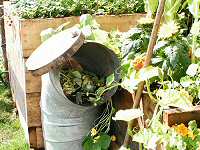 Novel compost receptacle in the Contemporary Green garden. (View bigger image.) Novel compost receptacle in the Contemporary Green garden. (View bigger image.) Gardens with sound environmental credentials were a huge theme at the show Gardens with sound environmental credentials were a huge theme at the show Gardens with sound environmental credentials were a huge theme at the show. Generally speaking, the RHS insists that all the gardens at its shows conform to certain environmental standards (e.g. using timber from renewable sources), but a large number of gardens at this year's Tatton show were 'themed' on environmental sustainability. Gardens with sound environmental credentials were a huge theme at the show. Generally speaking, the RHS insists that all the gardens at its shows conform to certain environmental standards (e.g. using timber from renewable sources), but a large number of gardens at this year's Tatton show were 'themed' on environmental sustainability.
The Contemporary Green garden (awarded a bronze medal by the RHS) was a beautiful and relaxing urban garden designed and built by Hulme Garden Centre, Fairfield Composting & Fairfield Materials Management. Raised beds, cleverly irrigated with collected rainwater, were used to grow fruit and vegetables for the kitchen. The Not a Waste garden (awarded a silver-gilt medal by the RHS), by Vale Royal Borough Council,
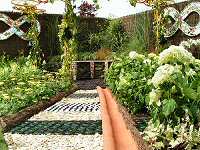 The Sun 4 Ever garden. (View bigger image.)
was another urban garden which aimed to show how the various receptacles used for collecting material for recycling by the council could be incorporated into the garden in an attractive way. The Sun 4 Ever garden. (View bigger image.)
was another urban garden which aimed to show how the various receptacles used for collecting material for recycling by the council could be incorporated into the garden in an attractive way.
The Sun 4 Ever (awarded a silver-gilt medal by the RHS) was a lovely little garden designed by Clusius College (a Dutch landscaping college) in conjunction with Tatton Park (Cheshire County Council). This garden used recycled materials in an imaginative and often fun way. One of its stated aims was to show the 'beauty of materials that have outlived their original purpose', and in this it succeeded admirably. The Recycled Garden by WRAP (Waste & Resources Action Programme) was a show feature designed to showcase peat-free compost as a growing medium and also included a number of innovative uses for recycled material.
Other gardens of note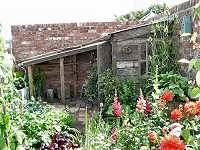 The Allotment Garden was a supremely relaxing and yet functional vegetable garden. (View bigger image.)
Several other gardens at the show caught my eye for one reason or another. Whilst it did not make heavy use of wildlife gardening techniques, the perennial planting of The Perennial Family Garden (awarded a bronze medal by the RHS), by Nicholas J Boult, drew my attention immediately because of the large numbers of hoverflies and bees that were attracted to it. Salvias and achilleas were particularly evident. And The Allotment Garden was a supremely relaxing and yet functional vegetable garden. (View bigger image.)
Several other gardens at the show caught my eye for one reason or another. Whilst it did not make heavy use of wildlife gardening techniques, the perennial planting of The Perennial Family Garden (awarded a bronze medal by the RHS), by Nicholas J Boult, drew my attention immediately because of the large numbers of hoverflies and bees that were attracted to it. Salvias and achilleas were particularly evident. And  if I had an allotment, I would want it to be just like The Allotment Garden (awarded a gold medal by the RHS) designed and built by Macclesfield Borough Council if I had an allotment, I would want it to be just like The Allotment Garden (awarded a gold medal by the RHS) designed and built by Macclesfield Borough Council if I had an allotment, I would want it to be just like The Allotment Garden (awarded a gold medal by the RHS) designed and built by Macclesfield Borough Council. This enormously attractive little plot was clearly a very functional vegetable patch, but so bucolic and relaxed in its design that you could easily imagine spending hours there just watching nature or reading a book. if I had an allotment, I would want it to be just like The Allotment Garden (awarded a gold medal by the RHS) designed and built by Macclesfield Borough Council. This enormously attractive little plot was clearly a very functional vegetable patch, but so bucolic and relaxed in its design that you could easily imagine spending hours there just watching nature or reading a book.
Overall impressions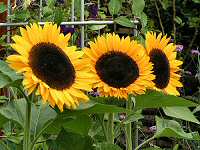 Sunflowers from Tomorrow's Garden for Wildlife. (View bigger image.)
I commented last year that the 2003 show did not directly offer that much to the wildlife gardener; but this year was quite different. Sunflowers from Tomorrow's Garden for Wildlife. (View bigger image.)
I commented last year that the 2003 show did not directly offer that much to the wildlife gardener; but this year was quite different.  Many of the gardens put a very heavy emphasis on environmental sustainability and encouraging biodiversity was often an aspect of this Many of the gardens put a very heavy emphasis on environmental sustainability and encouraging biodiversity was often an aspect of this Many of the gardens put a very heavy emphasis on environmental sustainability and encouraging biodiversity was often an aspect of this. An overt trend towards using recycled materials in the garden is one of the lasting impressions that I will take away with me. Most importantly, one or two of the gardens exploited the current 'state of the art' techniques for encouraging garden wildlife to the full. With few exceptions, these gardens were not of a particularly naturalistic idiom: in fact most incorporated some very contemporary and innovative design features. The interest in contemporary garden design is currently very strong and those gardens at Tatton 2004 that harmonised it with garden biodiversity were very welcome: they will, hopefully, make as much an impression on the public at large as they did on me. Many of the gardens put a very heavy emphasis on environmental sustainability and encouraging biodiversity was often an aspect of this. An overt trend towards using recycled materials in the garden is one of the lasting impressions that I will take away with me. Most importantly, one or two of the gardens exploited the current 'state of the art' techniques for encouraging garden wildlife to the full. With few exceptions, these gardens were not of a particularly naturalistic idiom: in fact most incorporated some very contemporary and innovative design features. The interest in contemporary garden design is currently very strong and those gardens at Tatton 2004 that harmonised it with garden biodiversity were very welcome: they will, hopefully, make as much an impression on the public at large as they did on me.
| First published July 2004. | |
Copyright Richard Burkmar 2004. Permission is hereby granted for anyone to use this article for non-commercial purposes which are of benefit to the natural environment as long the original author is credited. School pupils, students, teachers and educators are invited to use the article freely. Use for commercial purposes is prohibited unless permission is obtained from the copyright holder. |
Back to home page
Do you live in Merseyside? Interested in its wildlife? |